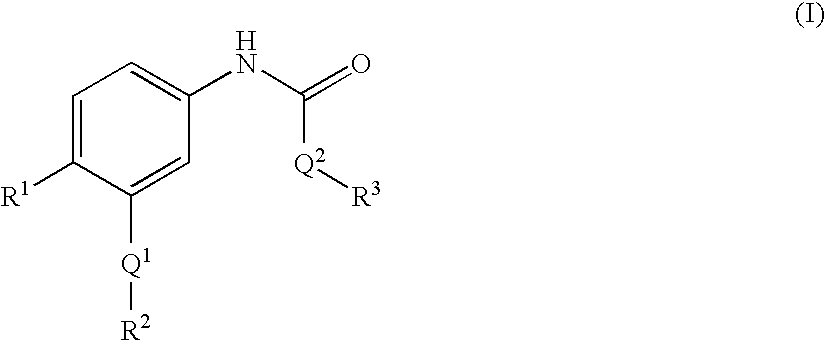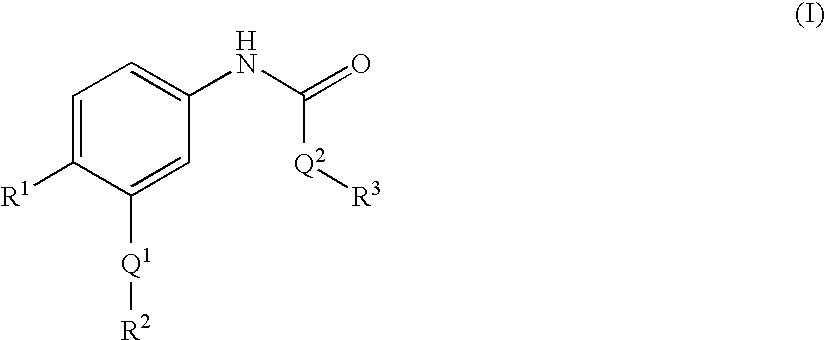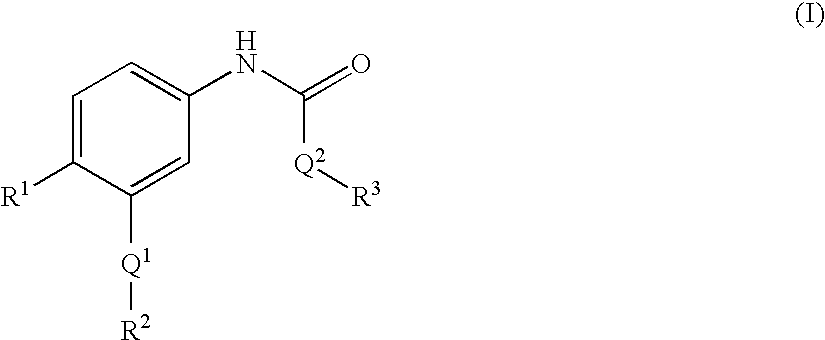Epha4 rtk inhibitors for treatment of neurological and neurodegenerative disorders and cancer
a neurodegenerative disorder and epha4 technology, applied in the direction of biocide, cardiovascular disorder, drug composition, etc., can solve the problems of largely failing neuronal regeneration, unable to fully regenerate connections, and the function of these molecules in pathological angiogenesis has not been well characterized
- Summary
- Abstract
- Description
- Claims
- Application Information
AI Technical Summary
Benefits of technology
Problems solved by technology
Method used
Image
Examples
example 63
N-(3-isoquinolin-7-yl-4-methylphenyl)-N′-phenylurea (Scheme 1)
[0278]
[0279]To a solution of 3-isoquinolin-7-yl-4-methylaniline hydrochloride (Intermediate 1.5.1, 15 mg, 0.06 mmol) in DCM (0.55 mL) and diisopropylethyl amine (0.01 mL, 0.06 mL) was added phenyl isocyanate (7 mg, 0.06 mmol). The reaction mixture was stirred at rt for 30 min, concentrated under a flow of nitrogen and purified by reverse phase preparative HPLC to provide N-(3-isoquinolin-7-yl-4-methylphenyl)-N-phenylurea as a TFA salt. MS M+1=354. 1H NMR (CDCl3, 400 MHz) δ 9.72 (s, 1H), 8.59 (d, J=7.2 Hz, 1H), 8.49-8.42 (m, 2H), 8.34 (d, J=8.1 Hz, 1H), 8.21 (d, J=8.1 Hz, 1H), 7.62 (s, 1H), 7.42 (d, J=8.1 Hz, 2H), 7.35-7.25 (m, 5H), 7.01 (t, J=8.1 Hz, 1H), 2.28 (s, 3H).
TABLE 2Examples prepared from various isocyanatesESEx #intermediateMode of prepStructureM + 1641.5.1See ex 63398651.5.1See ex 63394661.5.1See ex 63374671.5.1See ex 63368681.5.1See ex 63390691.5.1See ex 63388701.5.1See ex 63360711.5.1See ex 63394721.5.1See ex...
example 90
N-(3-isoquinolin-7-yl-4-methylphenyl)-2-(4-methylpiperazin-1-yl)-5-(trifluoromethyl)benzamide (Scheme 2)
[0280]
[0281]A solution of 2-bromo-N-(3-isoquinolin-7-yl-4-methylphenyl)-5-(trifluoromethyl)benzamide (intermediate 2.1.1, 30 mg, 0.06 mmol) and N-methyl piperazine (9 mg, 0.09 mmol) in THF (0.5 mL) was degassed with nitrogen for 2 min. Pd2(dba)3 (1 mg, 0.001 mmol), 2-dicyclohexylphosphino)-2′,4′,6′-tri-1-propyl-1,1′-biphenyl (X-PHOS, 2 mg, 0.005 mmol) and LiHMDS (31 mg, 0.19 mmol) were added in a dry environment. The reaction mixture was degassed with nitrogen for 2 min and heated to 65° C. for 16 h. The reaction mixture was concentrated in vacuo and purified by reverse phase preparative HPLC to provide N-(3-isoquinolin-7-yl-4-methylphenyl)-2-(4-methylpiperazin-1-yl)-5-(trifluoromethyl)benzamide as a TFA salt. MS M+1=505.
TABLE 2.2Examples of type 2.2ESEx #intermediateMode of prepStructureM + 1912.1.1MeNH(CH2)2NMe2, see example 90507922.1.1MeNH(CH2)3NMe2, see example 90521932.1.1Zn...
example 95
3-(dimethylamino)-N-(6-methyl-3′-nitrobiphenyl-3-yl)benzamide (Scheme 3)
[0282]
[0283]A solution of 3-(dimethylamino)-N-(3-iodo-4-methylphenyl)benzamide (intermediate 3.1.1, 45 mg, 0.12 mmol), 3-nitro-phenyl boronic acid (24 mg, 0.14 mmol) in DMF (0.5 mL) and 1M cesium carbonate (0.24 mL, 0.24 mmol) was degassed with argon for 2 min. 1,1′-bis(diphenylphosphino)ferrocene-palladium dichloride, DCM complex (4.8 mg, 0.006 mmol) was added and the reaction mixture was irradiated at 100° C. in a microwave for 10 min. The reaction mixture was filtered and purified by reverse phase preparative HPLC to provide 3-(dimethylamino)-N-(6-methyl-3′-nitrobiphenyl-3-yl)benzamide as a TFA salt. MS M+1=376.
TABLE 3Examples prepared from various boronic acids.ESEx #intermediateMode of prepStructureM + 1963.1.1See example 95375973.1.1See example 95375983.1.1See example 95409993.1.1See example 953611003.1.1See example 953701013.1.1See example 954011023.1.1See example 953591033.1.1See example 953311043.1.1See...
PUM
| Property | Measurement | Unit |
|---|---|---|
| Temperature | aaaaa | aaaaa |
| Volume | aaaaa | aaaaa |
| Molar density | aaaaa | aaaaa |
Abstract
Description
Claims
Application Information
 Login to View More
Login to View More - R&D
- Intellectual Property
- Life Sciences
- Materials
- Tech Scout
- Unparalleled Data Quality
- Higher Quality Content
- 60% Fewer Hallucinations
Browse by: Latest US Patents, China's latest patents, Technical Efficacy Thesaurus, Application Domain, Technology Topic, Popular Technical Reports.
© 2025 PatSnap. All rights reserved.Legal|Privacy policy|Modern Slavery Act Transparency Statement|Sitemap|About US| Contact US: help@patsnap.com



